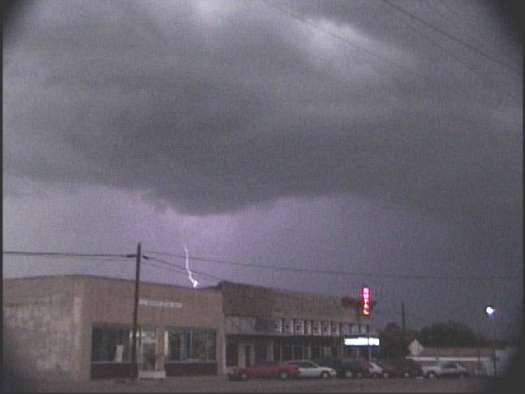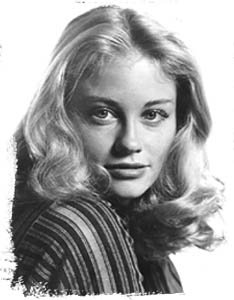| Back to First Page |
 |
Directed by Peter Bogdanovich 1971 The ultimate coming-of-age movie, but a lot more besides. |
|
Anarene, Texas, population 1131, is a no-account, dying township near Wichita Falls. The truck drivers don't slow down as they pass through it. A few old-timers live there, a few well-off employees of an oil company, a few wayward kids who've left home and gone into lodgings to get away from their folks, a few schoolteachers and their families, a young boy with a mental handicap - in short, the same kind of people who live everywhere else. This is Hicksville, Texas, and the year is 1951. It is solidly located in time and space, so real that we can almost smell it, feel the chill wind that sandblasts the buildings as it rips across the flat featureless West Texas plains, but the time and place don't matter because what the film deals with applies to all times and to all places. Sonny Crawford (Timothy Bottoms) is Everyman. He wants to be a good person, to be able to like himself, but he is weak, corruptible, easily deflected onto what he knows is the lower path. When we first meet him he has an enormous amount still to learn. He has to learn that actions have consequences, that other people have feelings and that when you trample on them they (and ultimately you) get hurt, that relationships create expectations and responsibilities, that the demands of kindness outweigh those of immediate sexual gratification: in short, what it is to be human. As the film unfolds, we see him grow into a decent, considerate human being despite all the forces pulling him in other directions. The triumph of the film's ending is that he doesn't run away from the things that he has done, he turns the pick-up truck around and goes back to face Ruth (Cloris Leachman), and more importantly himself. The heart-rending, inarticulate confrontation between Sonny and Ruth that ends the film is one of the all-time high-points of American cinema. This is how a film that seems at times unrelentingly downbeat and pessimistic can actually uplift and send you from the theatre believing that better is possible of human beings, that all is not hopelessness. This is a shocking film: not because of nudity, or anything to do with sexuality or violence, but because of honesty. Instead of glossing-over those parts of all our lives that we would prefer to deny and/or forget, "The Last Picture Show" selects them out as its subject matter and places them before us without compromise, without moralising, without means of escape. Some commentators have been inclined to blame the town itself and the crushing boredom of existence there for the moral shortcomings of its citizens, to over-stress the importance of a particular way of life and a particular moment in the history of the United States, as if people would behave better if there was more to do, more to aspire to, a greater variety of potential partners. Personally I think that this misses the point. The details of people's "lives of quiet desperation" would of course be different in another situatiuon, but whether in Anarene or Beverley Hills, Barcelona or Bangkok people have much the same choices to make as to how they are going to treat one another, much the same needs and wants and much the same opportunities to behave decently and achieve self-respect or to behave wretchedly and forfeit it. The town simply supplies a stage for the unfolding of completely universal aspects of human behaviour. It is the universality of the material that gives it its bite, that makes it at times downright uncomfortable. Which one of us has not, at some time or another, acted shamefully and tried to cover it up afterwards? Which of us has not experienced the mind-numbing clumsiness and embarrassment of early sexual encounters and lied about them? It would be time-consuming to summarise all of the plots and sub-plots of "The Last Picture Show" and really they are not crucial to the film: the two central aspects are character and atmosphere. We are introduced to Sam the Lion (Ben Johnson), the grizzled old cowboy who has settled down in Anarene and lives a lot in his own romantic version of the past, while providing a father-figure and role-model for some of the town's rootless teenagers; Ruth Popper, the neglected and near-suicidal wife of the High School football coach, who longs for some kind of affection and adventure in her empty life before she grows too old to enjoy it; Jacey Farrow (Cybill Shepherd) the pretty but self-centred, manipulative and spiteful teenager who comes from a family where this is the norm; Duane Jackson (Jeff Bridges) the aspiring High School football hero desperate to prove his manhood, full of pent-up violence and resentment which eventually find an outlet in signing-up to fight in Korea; and many, many more, each one of them a fully-rounded, believable human being without an ounce of carricature or exaggeration to mar their plausibility. Just look at the way the characters interact and spark off one another. Look at the relationship between Jacey and her mother, or between Sonny and his first lacklustre girlfriend Charlene Duggs (Sharon Taggart). Peter Bogdanovich must have made a pact with the Devil to extract performances of this level from all (yes, absolutely all) of his cast. As well as the human actors and actresses the town itself is a major player in the drama. Bleak, windswept, tatty and dying it seems to stand for the emotional void in the characters' lives, and also for the end of an age of youth and innocence that has been outgrown, both in the individual lives of the protagonists and in America itself. The Royal Cinema presents flickering escapist fantasies, like "Father of the Bride" (the 1950 version) based on a sentimental and tacky representation of family life that bears no resemblance to anything in the real experience of the people watching it; and "Red River", a 1948 Howard Hawks cowboy movie in which John Wayne stands in for Sam the Lion in his particular fantasy of what Texas used to be. It is all myth and fairytale, it has nothing to do with what life is really like, and in the end it too is taken away - the cinema closes down: the time has come to stand on one's own two feet, the picture show is over. If it is ever for a moment suggested that film is an inferior art-form to the novel or the play, "The Last Picture Show" provides all the counter-argument that one could possibly require. I would recommend that you see this film first when you are about seventeen years old, again at about twenty-five, and then at intervals of about a decade for the rest of your life. On each occasion you will see a different film, an even better one than you saw the time before.
LAST PICTURE SHOW TRIVIA
Archer City, Texas, where The Last Picture Show was filmed, has its very own (fairly modest!) home page, which you can visit here. Below is an e-mail from Brad Pippin, a former Archer City resident who got in touch with me after reading the above review. He kindly fills in a bit of background regarding the town and the film. Reproduced with Mr Pippin's permission. To answer your question, yes the Last Picture Show was filmed in my home town of Archer City, TX. It is quite a remarkable place. There are some points of interest to see in the town. I actually moved away in 1984, but I get back quite often to visit family. For a little history behind the movie...The book was written by Larry McMurtry. He grew up in AC, his father was a cowboy all of his life (Jeff McMurtry). Actually, his father and my Grandfather "cowboyed" together and were very good friends until Jeff's death in the early 1980's. Larry has written several other great books, with the most well-known being "Lonesome Dove" for which he was awarded the Pulitzer Prize. He also wrote a sequel to "The Last Picture Show" entitled "Texasville". This was made into a movie with the same basic cast, but the movie flopped. The sequel was also filmed in AC. Anyway, Larry McMurtry, who according to some in the Archer City area is a little eccentric (but in my humble opinion...he's a very nice man), moved back to AC in the early 1990's. Support for Mr. McMurtry was polarized in the town after the book and movie (Last Picture Show) came out in the early 70's. Some people were uncomfortable with the image it portrayed of the town. But when he wrote "Lonesome Dove," the town embraced him (it was a western with no naked women in it). He bought the local Country Club and lives there when he's in town. As far as the movie, the book is supposedly based on some "factual events." The main character (Bridges) is modeled after a "real" person named Sonny (deceased now). I knew him when I was growing up (I worked in a feed store in town), anyway, I asked him once if the movie was true? He replied, "well, ah' used to tell McMurtry about all my little escapades, I didn't know he was going to write a book about me!" As far as the town...The movie theater, actually called the Royal Theater, was torn down in the early 80's. A group of town people interested in increasing tourism are rebuilding the theater. It's a slow process, however, and I don't know when it will be completed. McMurtry runs a couple of huge used book stores in town (One was called the Blue Pig -- ref: Lonesome Dove, but I think they changed the name). I always said about AC that it's a great place to live, but I wouldn't want to visit there. But if you're interested in the Movie, not much has changed. The town has a population of about 1700 and that's been steady for the last 30 years or so. The people are friendly and hard-working. If you get out in the area, it's worth a stop. Well, I hope I've answered some of your questions. If you have others, feel free to drop a line. I only check my e-mail about once a week, so don't expect any quick answers. Take care,
Brad Chuck Jones was another visitor to this page who was kind enough to send me a photo as an attachment. His letter is reproduced (with his permission) below: David,
I can't agree more regarding your comments towards "The Last Picture Show".
Hope you enjoy the attachment. You should recognise the building even though the picture is a bit blurry.
The Royal is center bottom frame. The Cafe (Sam The Lion's) is at bottom left. Best Regards, Chuck Jones.
Thanks, Chuck. Brilliant picture!
What a poster this would have made for the movie: the storm clouds gathering over Anarene!
The strikingly beautiful teenage Cybill Shepherd, who got her first break in The Last Picture Show and went on to great things in Hollywood and on TV. You can read about her later career (or send her an e-mail) at her official home page here
TO READ OR SIGN THE GUEST BOOK JUST CLICK ON THE |


